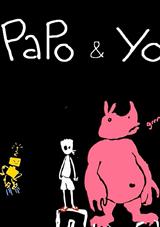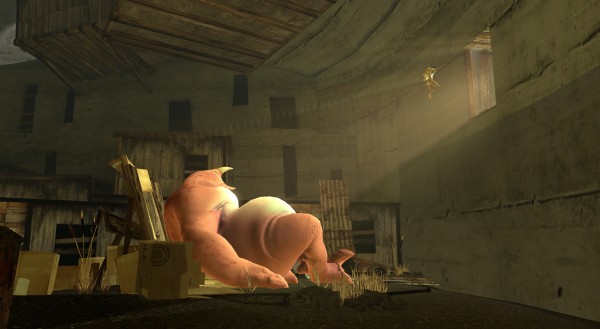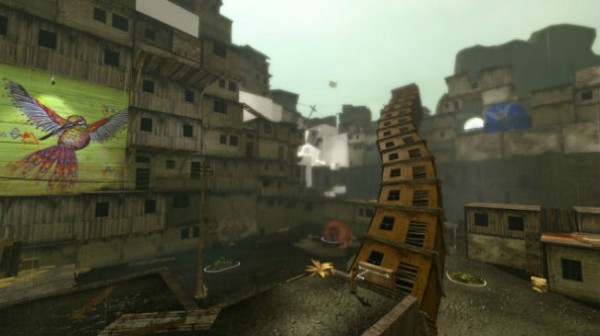I am not the main character in Papo & Yo, and neither are you. Vander is.
Before Papo & Yo (translated to the nicknamed “Papo and I”), I knew video games were player-centric. In every other game’s given galaxy (excepting The Binding of Isaac), all the heavenly bodies revolve around me, from the Mushroom Kingdom’s shrooms to the user interface in Halo: Reach. Without derailing into the “Should games be fun?” argument, a game’s method and fiction had to stroke my player ego, build me up, and keep me moving forward.
In Papo & Yo, the downloadable, autobiographical puzzle-adventure game from Minority Media and Creative Director Vander Caballero, empathy underpins the most pure auteur piece in gaming to date. Before meeting a single character in the game, and before gaining any control, the player meets the auteur, Vander, with this exposing dedication: “To my mother, brother, and sisters with whom I survived my monster father.”
Just by waxing allegorical, personal, and invading in its prologue, I’m already inclined towards empathy instead of entertaining entropy. I haven’t yet learned about Vander’s father’s alcoholism or the years of physical abuse or his desperate escape into his imagination, and I’m already led into some removed garden of guilt. Then I see the boy Quico (a personified Vander), knees hiding his face, sitting on the floor in a dark closet, a heavy, sloppy plod sounding just outside the door, and the monster’s shadow pacing back and forth. His only escape, like the player, is through an illuminated, imaginary portal on the wall.
The extended metaphor finds Quico traveling across an elastic, evolving South American neighborhood with his robot companion/jetpack Lula and his father’s living symbol, Monster, looking for a cure to Monster’s addiction. The sluggish, lazy rhino-dad sleeps often, doubles as a trampoline, moves only for food that Quico finds, and loves to eat frogs. Chowing down on the amphibians sends Monster into an unbridled rage marked by chasing and violently discarding Quico, a trauma which is only ended by rotten blue fruit or eventual slumber. Laying it on thick, as they say, is the method and the purpose of Papo & Yo.
When I’m given control of Quico, and I think that I might unravel the tenuous emotional balance by jumping through textures in the level or spamming my companion robot call. “Luuuuula. Lula? Luuuuula. Lula? Luuuuula…” And so on. The empty, brown favela is still and patient around me. And after the first of many “push or pull a lever” puzzles, I see where I was wrong. This game is not about a toolset, or encouraging inventive solutions, glorifying my wonderment, or saving the day. It’s about Vander’s story.
For some, Papo & Yo won’t even be enough to call a game. It might come across as an interactive story where the participatory bits only serve to reinforce the narrative concept of pre-determined, maybe useless attempts at finding resolution. By diving deeper into a world of bending columns, caterpillar houses, chomping lawns, and magical fruits and frogs, the player gives in to the escapism of the media and Vander’s private escape. According to Vander, “When I played games, I felt I was in control and that I was protected.”
Take a recurring instance where Quico needs Monster to walk onto a platform to raise him to a different floor. The player finds the fruit, throws it onto the platform, then runs to find the switch. In the meantime, Monster finds the fruit, eats it, leaves the platform, then goes back to his napping, forcing the player to do the process over again. Nothing about the tedious process is particularly damning or particularly fun, but it absolutely reinforces the dynamic of one-way indifference in Quico and Monster’s relationship. Expanded out through metaphor, what was a cumbersome buddy system becomes a meaningful design choice.
So, to consider Papo & Yo in terms of its play components would miss the clear purpose of a game that overtly insists on one individual’s reimagined experience. Just in case the player forgets that, the game even inserts slow-motion, black-and-white vignettes with Quico and his human father.
What’s more, Papo & Yo’s system of co-dependence between Quico and Monster is flimsy in practice, and Quico’s motivations go relatively unsupported outside of the metaphor. There’s only so much pity I can conjure for a digital boy and his horrifying, real problems. The dedication at the beginning, then, becomes absolutely crucial to sustaining the poignancy of the narrative, and establishing a relationship from the player to Quico to Vander. That’s the connection that matters, because it creates genuine, honest-to-goodness empathy.
Opening up that human conversation in a game takes insistence on honest, relatable gameplay and an equally honest ending. Papo & Yo sticks the landing, and does not tease a sequel. After I put the controller down, emotionally drained and unsatisfied (by design, I think), I wondered what it might be like to find other game developers taking the same approach; to build a game where a connection with the developer’s personal struggles and triumphs are the axis around which the rest of the game rotates, where the play mechanics are secondary and will likely suffer in service to creating an emotional bond.
The conclusion, I imagine, would be the end of gaming as we know it and a shame. A Mario game, for example, would lose all of its pluck and charm if it weren’t so distantly related to Shigeru Miyamoto’s childhood spelunking. There’s something to be said in the defense of fantasy, especially fantasy that pulls on human elements to tell an engaging story without being historic. There’s also something to be said for the purity of games with only emergent narrative like Super Hexagon and Pong.
But Papo & Yo has convinced me that there’s also an important new frontier for games to explore, and that the auteur developer is at the heart of it. Rather than adapting existing IPs to fit the framework, though, I’d urge developers to consider Minority’s example. It’s insistence on the game’s driving metaphor made for some inconsistent puzzle-platforming and nailed the empathic component. As gamers, we may have to mature along with the medium, and Papo & Yo is a heart-breaking, compelling place to start.





















